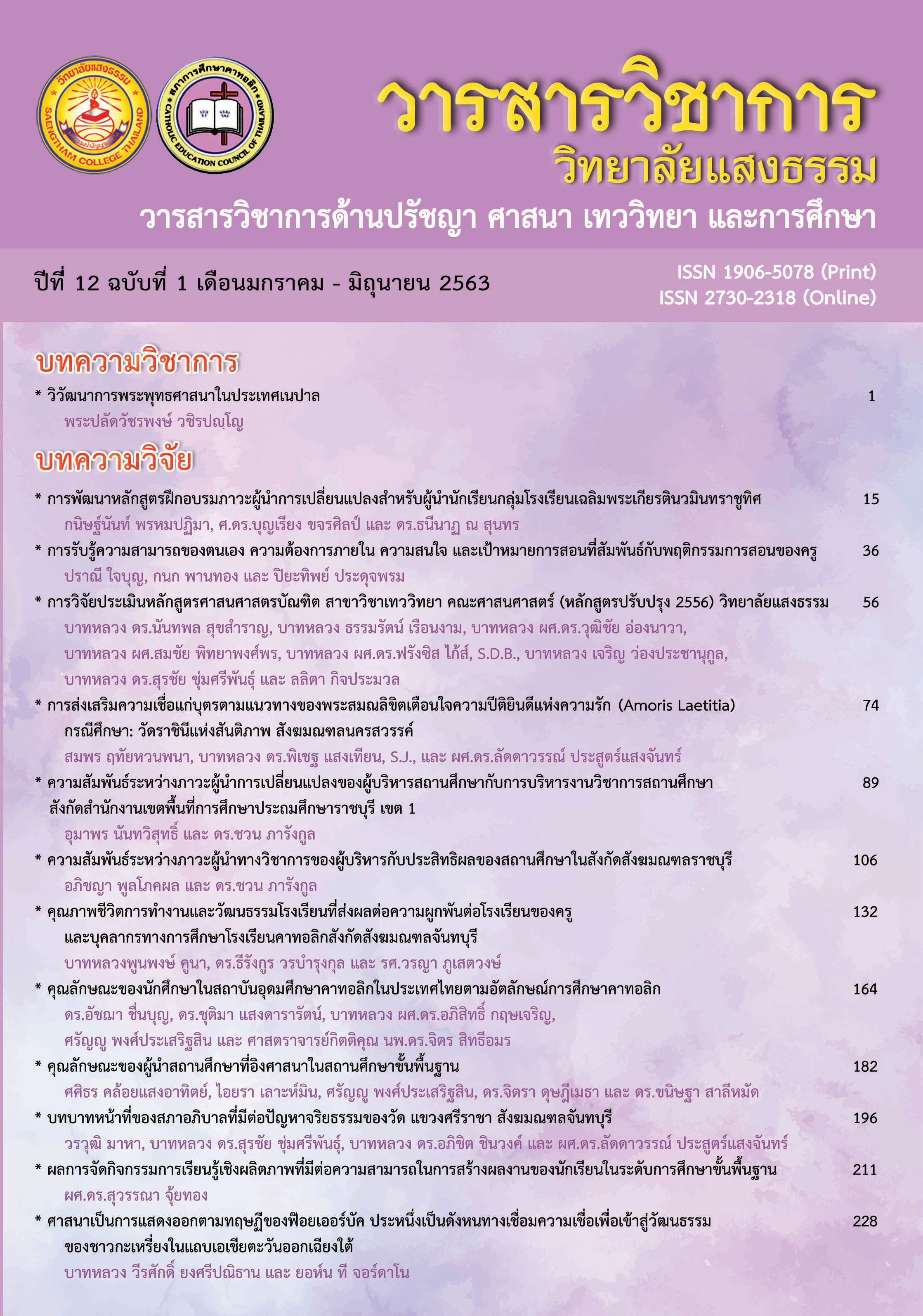A Study of Self-Efficacy, Intrinsic Needs, Interests, and Teaching Goal as They Relate to Teacher Instructional Behaviors.
Main Article Content
Abstract
The research purposes were 1) to confirm the factors of self-efficacy, intrinsic needs, interests, teaching goals, and teacher instructional behaviors variable 2) to study multiple correlations of self-efficacy, intrinsic needs, interests, teaching goals, and teacher instructional behaviors variable 3) to build multiple regressions of teacher instructional behaviors with self-efficacy, intrinsic needs, interests, and teaching goals variable. Samples: 157 teachers by proportional stratified random sampling and 1,570 questionnaires’ students by simple random sampling. Research instruments are teacher’s questionnaire and student’s questionnaire. Data were analyzed by confirmatory factor analysis, multiple correlation analysis, and multiple regressions analysis. The research findings were 1) self-efficacy, intrinsic needs, interests, teaching goals, and teacher instructional behaviors have construct validity 2) predictor variable: self-efficacy, intrinsic needs, interests, and teaching goals; and criterion variable: teacher instructional behaviors have significant correlation. 3) self-efficacy, intrinsic needs, interests, and teaching goals could be used to teacher instructional behaviors coping at 25.60%. The multiple regression equations were as follows: Multiple regressions in the form of raw score was: TIB = .744 + .154(SE)** + .151(IN)** + .103(INT)* + .157(TG)** Multiple regressions in the form of standard score was:
TIB = .154Z**SE + .151Z**IN + .103Z*INT + .157Z**TG **p <.01 *p <.05
Article Details
- The articles have been published in academic Saengtham College Journal Is owned by Saengtham College Do not republish all text. Except permission from Saengtham College.
- Any content and comments Published in academic Saengtham College Journal. It is the responsibility of the author only.
References
กระทรวงศึกษาธิการ. (2551). หลักสูตรแกนกลางการศึกษาขั้นพื้นฐาน พุทธศักราช 2551. กรุงเทพฯ: โรงพิมพ์ชุมนุมสหกรณ์การเกษตร.
คริสวัฒน์ บุญญะสิทธิ์. (2554). ความต้องการในการพัฒนาสู่มาตรฐานวิชาชีพครูของครูผู้สอนในสถานศึกษาสังกัดสำนักงานเขตพื้นที่การศึกษาปทุมธานี เขต 2. วารสารวิชาการมหาวิทยาลัยปทุมธานี, 3(3), 116-121.
ดนุรี เงินศรี และณัฏฐภรณ์ หลาวทอง. (2552). การพัฒนาโมเดลเชิงสาเหตุและผลของการรับรู้ความสามารถของครูมัธยมศึกษา สังกัดสำนักงานเขตพื้นที่การศึกษากรุงเทพมหานคร. วารสารอิเล็กทรอนิกส์ทางการศึกษา จุฬาลงกรณ์มหาวิทยาลัย, 4(1), 1231-1244.
ทนงศักดิ์ นันทกร, สมศักดิ์ สีดากุลฤทธิ์ และจำนงค์ ศรีมังกร. (2559). แรงจูงใจในการทำงานของครู สังกัดสำนักงานเขตพื้นที่การศึกษามัธยมศึกษา เขต 19. วารสารมนุษยศาสตร์และสังคมศาสตร์ มหาวิทยาลัยมหาสารคาม, 35(4), 56-69.
พรรณทรี โชคไพศาล และจุไรรัตน์ สุดรุ่ง. (2554). พฤติกรรมการนิเทศที่ส่งผลต่อการเปลี่ยนแปลงพฤติกรรมการสอนของครู. วารสารอิเล็กทรอนิกส์ทางการศึกษา จุฬาลงกรณ์มหาวิทยาลัย, 6(1), 1501-1515.
โรงเรียนคาทอลิกสังกัดสังฆมณฑลจันทบุรี. (2553). ระเบียบโรงเรียนคาทอลิกสังกัดสังฆมณฑลจันทบุรี พ.ศ.2553. ชลบุรี: ศรีราชาสิ่งพิมพ์.
โรงเรียนคาทอลิกสังกัดสังฆมณฑลจันทบุรี. (2560). รายงานสถิติครูและนักเรียน. (เอกสาร). ชลบุรี: โรงเรียนคาทอลิกสังกัดสังฆมณฑลจันทบุรี.
ศุภชัย สว่างภพ, ประวิต เอราวรรณ์ และไพบูลย์ บุญไชย. (2555). ปัจจัยที่สัมพันธ์กับประสิทธิภาพการสอนของครูกลุ่มสาระการเรียนรู้คณิตศาสตร์ ช่วงชั้นที่ 3 จังหวัดศรีสะเกษ. วารสารการวัดผลการศึกษา มหาวิทยาลัยมหาสารคาม, 17(1), 293-304.
สันติ บุญภิรมย์. (2557). การบริหารจัดการในห้องเรียน. กรุงเทพฯ: ทริปเพิ้ล เอ็ดดูเคชั่น. สายใจ อินทรณรงค์. (2554). การวิเคราะห์องค์ประกอบเชิงยืนยันการรับรู้ความสามารถในตนเองของครู. วารสารศึกษาศาสตร์ มหาวิทยาลัยบูรพา, 22(3), 154-168.
สำนักนโยบายและยุทธศาสตร์ สำนักงานปลัดกระทรวงศึกษาธิการ กระทรวงศึกษาธิการ. (2559). แผนพัฒนาการศึกษาของกระทรวงศึกษาธิการ พ.ศ.2560-2564. กรุงเทพฯ: โรงพิมพ์สำนักงานปลัดกระทรวงศึกษาธิการ กระทรวงศึกษาธิการ.
อเทตยา แก้วศรีหา, กระพัน ศรีงาน และโกวิท วัชรินทรางกูร. (2558). ปัจจัยที่ส่งผลต่อประสิทธิภาพการสอนของครูผู้สอนหลักสูตรประกาศนียบัตรวิชาชีพในโรงเรียนมัธยมศึกษา สังกัดสำนักงานเขตพื้นที่การศึกษามัธยมศึกษา เขต 32. วารสารวิจัยและพัฒนา มหาวิทยาลัยราชภัฏบุรีรัมย์, 10(2), 57-66.
Bandura, A. (2004). Self-efficacy. Encyclopedia of Health & Behavior, 2, 708-714.
Butler, R., & Shibaz, L. (2008). Achievement goals for teaching as predictors of students' perceptions of instructional practices and students' help seeking and cheating. Learning and Instruction, 18(5), 453-467.
Deci, E. L., & Ryan, R. M. (2002). Handbook of self-determination research. University Rochester Press.
Holzberger, D., Philipp, A., & Kunter, M. (2014). Predicting teachers’ instructional behaviors: The interplay between self-efficacy and intrinsic needs. Contemporary Educational Psychology, 39(2), 100-111. doi: http://dx.doi.org/10.1016/j.cedpsych.2014.02.001
Long, J. F., and A. W. Hoy. (2006). Interested instructors: A composite portrait of individual differences and effectiveness. Teaching and Teacher Education, 22(1), 303–314.
Maulana, R., Opdenakker, M. C., & Bosker, R. (2016). Teachers' instructional behaviors as important predictors of academic motivation: Changes and links across the school year. Learning and Individual Differences, 50, 147-156.
Schiefele, U., & Schaffner, E. (2015). Teacher interests, mastery goals, and self-efficacy as predictors of instructional practices and student motivation. Contemporary Educational Psychology, 42, 159-171.
Schiefele, U., Streblow, L., & Retelsdorf, J. (2013). Dimensions of teacher interest and their relations to occupational well-being and instructional practices. Journal for educational research online 5, 1, 7-37.


